The State of the Speaking Industry: 2020 Report
Originally Posted On: https://speakerflow.com/the-state-of-the-speaking-industry-2020-report/ Since SpeakerFlow launched in May 2019, we’ve been huge advocates for two things above everything else: driving with data...Tuesday, January 28th 2020, 3:27 am
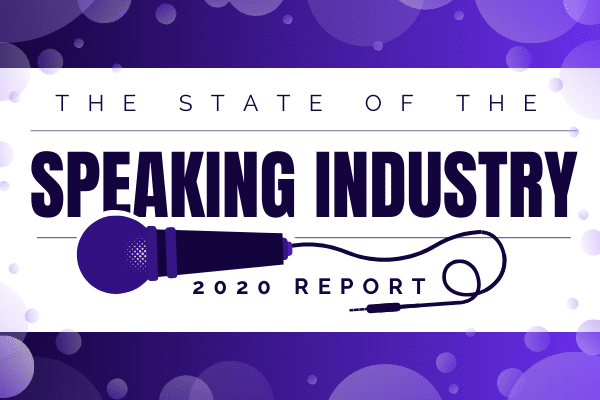
Since SpeakerFlow launched in May 2019, we’ve been huge advocates for two things above everything else: driving with data and practicing what we preach. Because of this, in working with our clients, we’ve been able to learn a lot about the speaking industry as well as how we can best serve it. Although some of this came from speaking candidly with speakers around the world, we also shared a survey with them. As a result, we not only gained insights into how speakers felt about their respective businesses. We were also able to collect a ton of information about speakers’ average gig count (and speaking income) each year. This blog is all about passing those insights on to you and outlining how best to rise above the averages as we enter 2020.
Before I launch into the numbers, please note that while these figures represent the speaking industry as a whole, they originate from the answers of roughly 300 survey participants. Consequently, although the percentages mentioned throughout this guide hold true to the majority of speaking businesses, they are not necessarily inclusive of all speaking businesses.
On that note, without further ado, let’s jump on in! Below are the primary topics we’re going to cover, for your reference. 
- Speaker Sales in 2020
- Speaker Marketing in 2020
- Speaker Operations in 2020
- How You Can Use These to Crush 2020
- 1. Start tracking sales in your speaking business, so you’ll know what’s working and what isn’t.
- 2. Invest more time in outbound prospecting – All of our data proves this works.
- 3. If you haven’t updated your brand in a while, now is the time.
- 4. Block off a few hours each week to work on your speaking business rather than in it.
- 5. Reach out for help where you need it!
Speaker Sales in 2020
First and foremost, let’s talk about sales. As with any small business, there are many factors that contribute to the success of a speaking business. However, from automated selling to use of traditional sales tactics, it can be difficult to distinguish what is worth continuing and which practices you should leave behind. Additionally, when you’re able to pinpoint things that definitely aren’t working, it’s easy to doubt yourself. We see this time and time again when it comes to inbound and outbound sales practices in the speaking industry. Looking at your own speaking business, how many times have you thought, “I want to increase my prices, but what are my competitors charging?” or “I want to adjust my sales process, but how do I know if I’m making the right changes?”
Important Sales Stats to Know
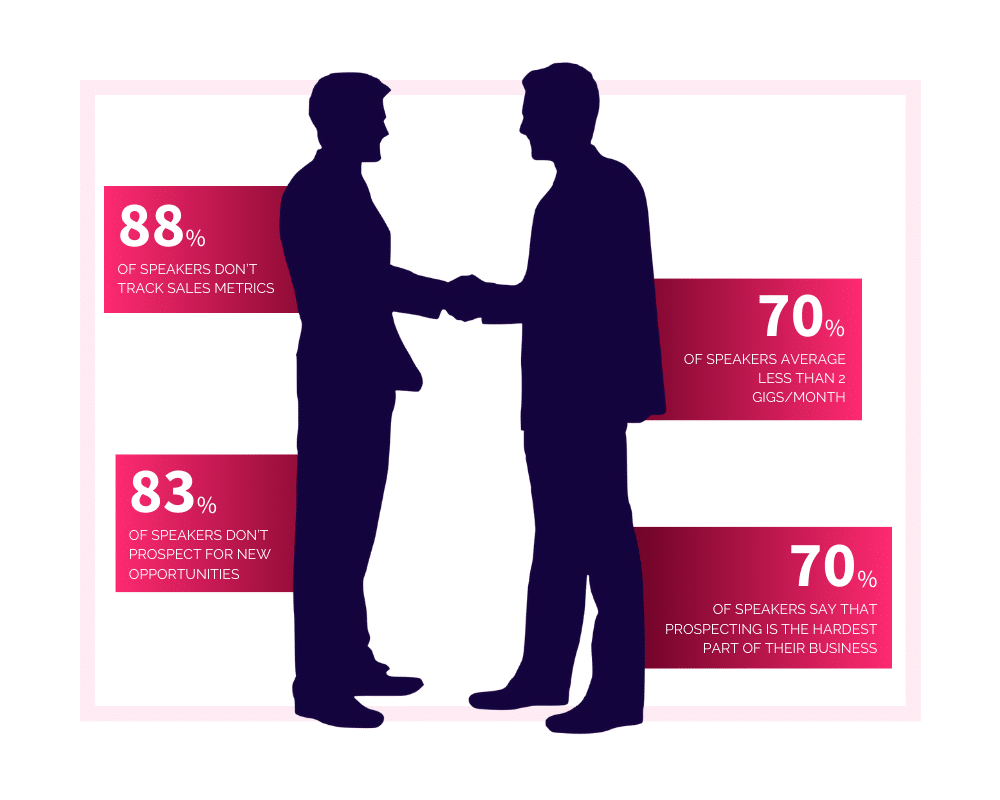
Fortunately, if these are questions you’ve asked, you’re far from alone. In fact, we found that 80% of those we surveyed lack confidence in their sales process. Period. That means, in a room full of speakers, almost everyone there is doing something different when it comes to sales. Some prefer old school sales tactics, like making connections in person, while others take a more modern approach, running their speaking business remotely. In light of this, it’s important to note that no one way is correct, either! Depending on your focus industry, certain tactics may be more appropriate than others.
That’s where the numbers come in. As of right now, 88% of the speakers we surveyed don’t track sales metrics within their business. From the industries of their clients to their greatest referral sources, few track the finer details of their sales processes. In fact, across speaking businesses, there’s only one area in which good data is consistently collected: total numbers of gigs. As a result, although you may be able to see how many gigs you have on the books, you don’t have clear indicators of what tactics are getting you those bookings.
Ultimately, this leads to either decreasing growth in your speaking business or a lack of growth altogether. Numerically, we can see this in the average number of gigs booked each month, with 70% of those we surveyed booking less than 2/month and 53% booking less than 1/month. In total, only about 7% of those surveyed said that they’re booking 4 or more gigs each month. It’s a little hard to find out what’s working when you don’t have any gigs to work with!
Inbound Sales Stats
That brings me to the first part of sales in the speaking industry: inbound sales. As of right now, 50% of the speakers we’ve surveyed are booking the aforementioned gigs solely through referrals. This includes referrals from fellow speakers, event planners in their focus industry, and past clients. Subsequently, 33% of speakers say that following up with those leads could be more efficient. So, for example, you are sent an email from a past client that introduces you to an event planner. What is your process for contacting them? How do you make sure to reach out if they don’t answer? For many speakers, there isn’t a clear answer, resulting in a ton of lost sales. In other words, the average gig count we mentioned in the last section could be higher if more speakers had the resources and support to keep those referrals from slipping through the cracks.
Outbound Sales Stats
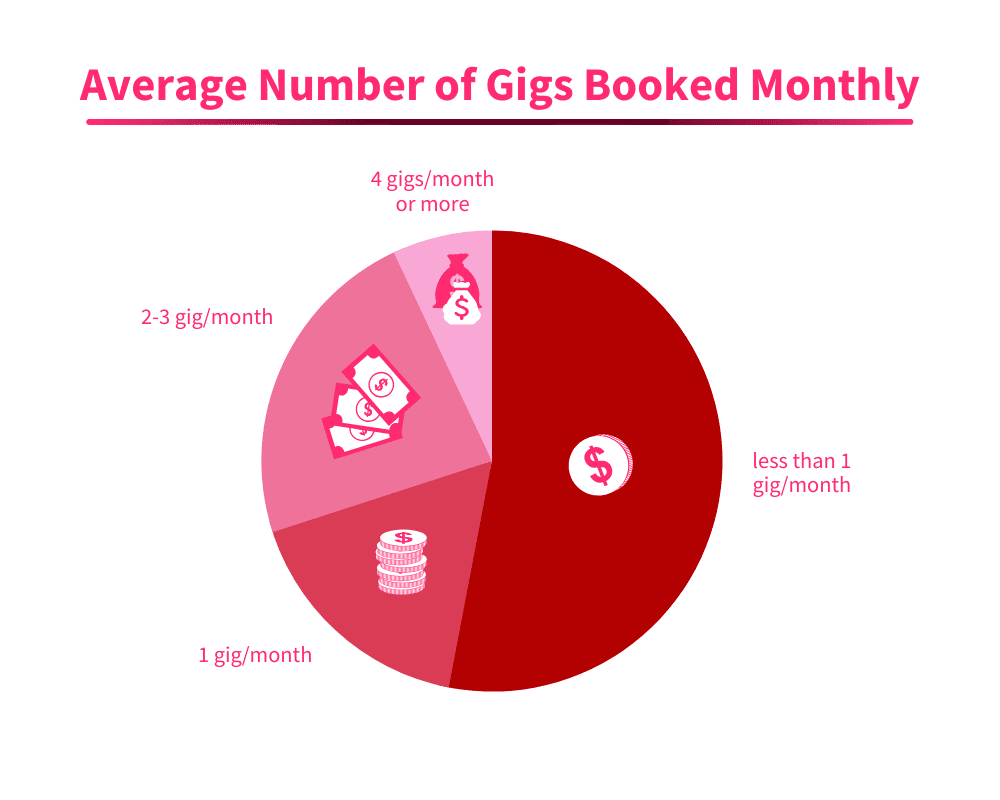
On the flip side of sales in the speaking industry, part of the blame for such low numbers also comes from outbound sales. These include your efforts to research and reach out to event planners for whom you want to speak. These also include the efforts of your salesperson or assistant, when they contact event planners or submit applications on your behalf. Although this is an older sales technique, it’s undeniably effective. In part, this is because many event planners are crunched for time, making it easier for them to choose the speaker that contacts them directly. Sounds like a pretty easy way to get booked, right?
Right now, many in the speaking industry would disagree. Admittedly, picking up the phone and calling event planners yourself isn’t as easy as a referral. However, going after the sales yourself is one of the key ways to making revenue in your speaking business predictable. You never know when a referral’s going to come through the door but you can easily track the decision-makers you’re negotiating with. Nonetheless, 83% of the speakers we surveyed don’t prospect for new opportunities. Additionally, 70% said that prospecting for new opportunities is the hardest part of their business while 85% said their prospecting process could be more efficient. In short, there is a massive part of sales of the speaking industry that is being overlooked, even though it leads to immense profit! We’ll talk more shortly about changing this in your own speaking business.
Speaker Pricing Stats
But before we talk strategy, let’s break down the last set of stats in our list when it comes to sales. I’m talking about the amount of money speakers are charging per gig. Although it’s easy to immediately jump to the better-known speakers and assume high averages, the numbers are actually pretty surprising. In our 2019 survey, 55% of the speakers surveyed said they are making $7500 US or less per gig while, of the remaining 45% surveyed, almost all were making between $7500 and $12,500. There are a number of reasons for this, although the most commonly cited was purely a lack of confidence. To put it plainly, many speakers don’t know how much they are worth and so undercut themselves.
What This Means
So, what does this mean for sales in the speaking industry in 2020? More than anything these stats demonstrate three things. First, as I mentioned initially, speakers aren’t collecting data within their businesses, so they can’t make educated decisions. This means that, when it comes to choosing a focus industry or identifying your best audiences, you might be missing the boat. Second, many speakers have adopted the wish, “I just want leads to come to me”. While that sounds amazing and it definitely can happen, it takes time. If you want to predictably increase the number of times you’re booked each year and the amount of money you make, you have to consistently prospect for new leads yourself. Third, these stats also show that because speakers aren’t tracking their sales data or handling sales themselves, their overall value suffers.
To put it simply, tracking data makes it easier to identify your most profitable audiences and industries. From there, once you’re reaching out to event planners in these areas, you’re more likely to be hired. More gigs means more recognition, more referrals, and being able to charge more per gig. In short, every aspect of selling – from outbound emails to returning clients – is interconnected. If you build a firm foundation and consistently track your progress, you can more easily analyze your processes, leading to a ripple effect of growth throughout your speaking business. Later in this guide, we’ll break down exactly how to get started. I promise if we can do it, you can do it, too. 
Speaker Marketing in 2020
Moving on, in addition to sales, the speaking industry thrives on marketing. Similarly to sales, the term “marketing” includes a variety of strategies and practices. Among speakers, the most common of these are writing blogs, managing social media accounts, and maintaining a website. In essence, each tenant of a marketing strategy allows you to connect with past clients, potential clients, and fans from past events, and, in many ways, sales and marketing work together. In an ideal situation, high-quality marketing brings in more leads, allowing you to make more sales and use your income to increase your marketing. Basically, a solid process is like a positive feedback loop of marketing efforts bringing in sales, which are then used to further fund that marketing.
Important Marketing Stats to Know
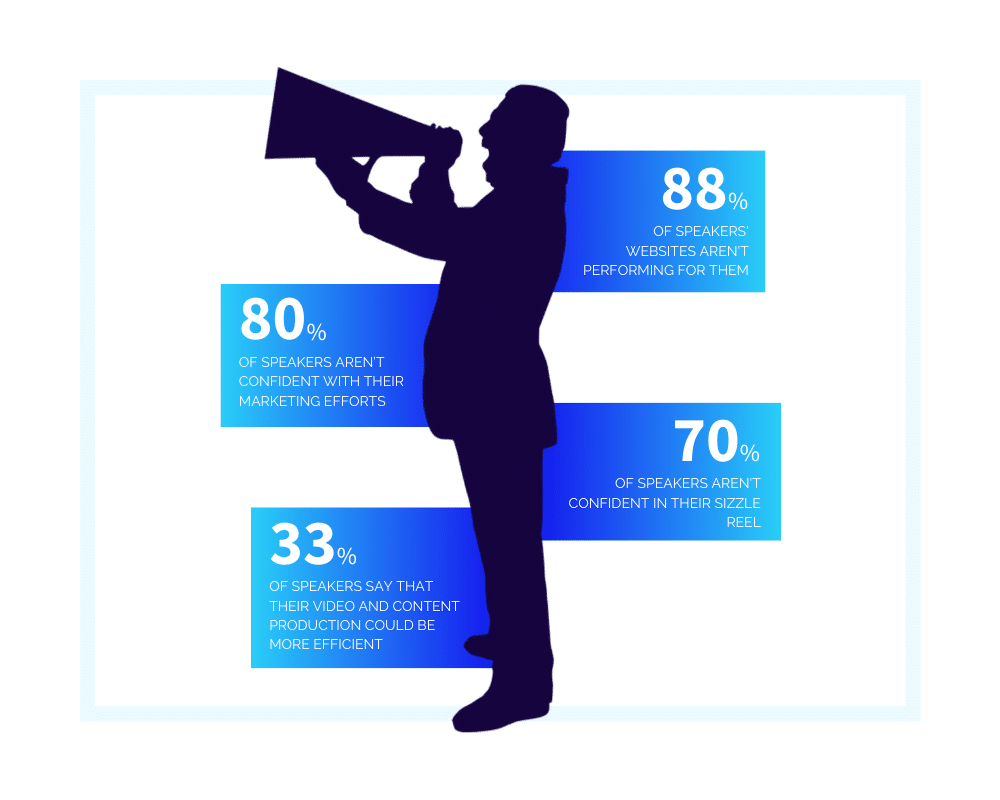
However, like we saw with speakers’ sales, there’s a similar lack of data tracking, analysis, and confidence when it comes to marketing. In fact, in our surveys over the last year, 80% of the speakers we met said they aren’t confident with their marketing efforts. Additionally, when it comes to individual pieces of marketing, this hesitation is amplified, with 88% saying their website isn’t performing well and 70% saying they don’t feel good about their sizzle reel. We also heard from 33% of participants that their processes for producing video and content could be more efficient. Unsurprisingly, this ties in closely with the concerns and struggles we say, when it came to sales. More data collected – in sales and marketing – means more easily being able to adjust your processes and systems. Again, being able to do this confidently and accurately ultimately compounds for more exposure and revenue. Win win!
What This Means

But, for the time being, what do these numbers mean for existing businesses in the speaking industry? First and foremost, these mean that although 57% of speakers want to be booking 2 or more gigs per month, they’re unlikely to reach that goal without taking action. Remember the sales recommendations we already covered? These are the actions I’m talking about. In marketing terms, collect as much data from your website, social media profiles, and content areas (YouTube channel, blog, etc.) as possible. Then, see which avenues are getting the most attention and maximize those.
The second conclusion we can draw from this data is the need for marketing modernization, specifically when it comes to websites. Looking at your own website, when was the last time you updated its appearance? Does it have a padlock in the URL bar, showing that it’s secure? Does it clearly indicate who you serve and why, and is there a clear call-to-action for site visitors? If you answered “no” to any of these questions, or if you’re not confident in your website, no worries! Later in this guide, I’ll share some tips, tricks, and tools to make your website function like a full-time salesperson. That way, you can be confident that your marketing efforts are working for you in the background while you’re crushing it on stage.
Lastly, these marketing statistics echo one of the underlying concerns we hear over and over from clients: “I don’t have enough time to manage all of this.” Truth be told, balancing your sales and marketing with travel isn’t exactly a walk in the park. Fortunately, there are resources out there to either (a) handle your marketing for you, (b) advise you, so you know you’re moving in the right direction, or (c) strategize with you so you can prioritize which parts of your marketing need updating first. I’ll go through these shortly, too, but, again, if we at SpeakerFlow can handle this, you’re going to be just fine. 
Speaker Operations in 2020
Finally, the last of the three business pillars, after sales and marketing, is operations. I’m talking about organizing your files, managing invoices – anything that allows your speaking business to run smoothly. Within a standard small business, many operations tasks are delegated between team members. However, within a speaking business, the majority of these projects and responsibilities tend to fall on the speaker. This is especially true if you are an up-and-coming speaker and have yet to expand your team. Additionally, if you’re completely new to the speaking industry and are starting from scratch, it can be difficult to find resources for helping you manage your new speaking business’s operations.
As of right now, the toll this is taking within the speaking industry as a whole is readily apparent. According to our survey participants, 80% said they rarely, if ever, work on their business. All of their work is in the business. In other words, because their sales and marketing operations aren’t organized, they also don’t have time to organize their operations. They’re too busy trying to bring in money in the first place!
Looking back in the last section, this is another example of the interconnectivity between sales, marketing, and operations. I mentioned a positive feedback loop in which investing in marketing leads to sales, which provides for more marketing funds. In the same way, when you neglect one of these three pillars, the effect compounds in a negative way.
Important Operations Stats to Know
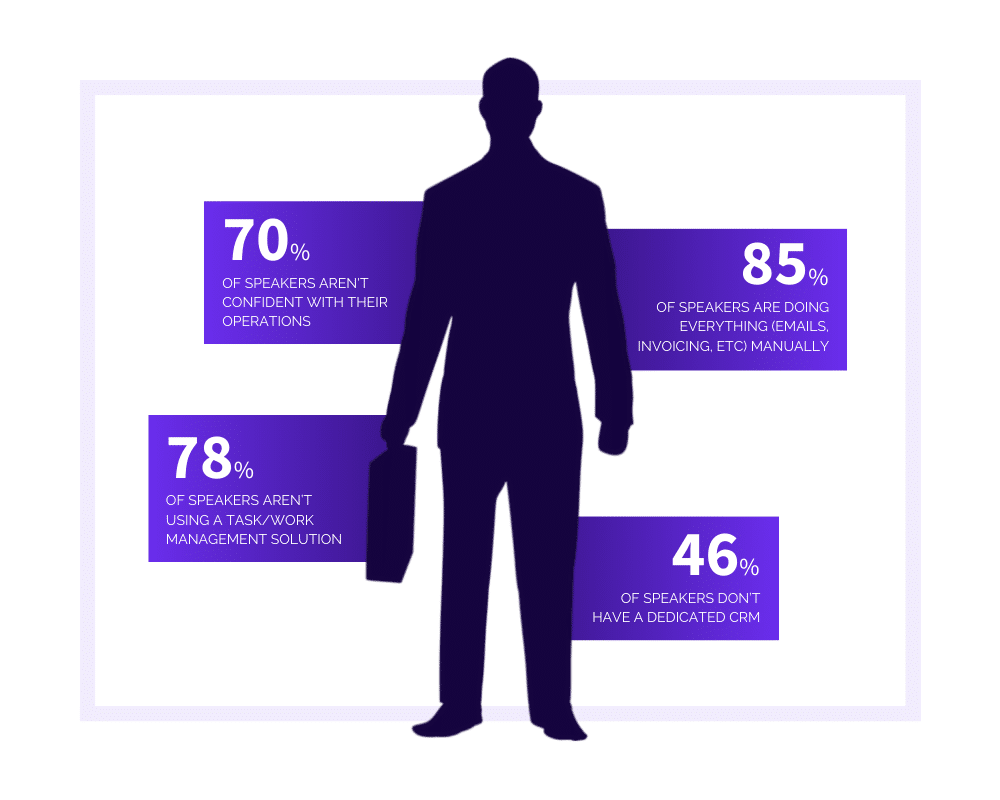
Overall, this struggle to keep up with operations is evident numerically as well as emotionally, as seen in conversing with speakers. To be exact, 70% of the speakers we surveyed say they aren’t confident with their business operations as a whole. Like we saw in sales and marketing, while there are many aspects of operations and many options for handling each one, it can be hard to know which are the best for your speaking business. Because of this, many speakers take the “do what everyone else is doing” approach. In these cases, while the effort is admirable, this also leads to the spread of misinformation throughout the speaking industry.
Let’s look at operations systems, for example. In our survey, 78% of participants aren’t using a task management system and 46% don’t have a customer relationship management system (CRM). While the latter also ties into sales, both of these systems are integral parts of a solid operations process. This also makes it easy to say, “I know I need a CRM, and Joe uses this one. If it works for him, it must work for me, too.” While this is true in some ways – I’m not saying you don’t need a CRM – it’s important to know that the CRM one speaker uses might not be a good fit for you. I’ll touch more on this towards the end of this guide and share my favorite tools and technology for operations.
That brings me to the last important statistic for speaking industry operations: the use of automation. When we surveyed speakers in 2019, 85% of respondents said they’re doing everything manually. In terms of operations, this means everything from sending emails to creating tasks to creating proposals is all done by hand. While this can result in greater personalization in each email or proposal, it also takes up a ton of time. Plus, the vast majority of these tasks can be accomplished by automation, including features of the CRMs and task management systems we talked about earlier.
What This Means

In light of these stats, this indicates one thing above all else, when it comes to operations in the speaking industry: the need for technology. Even more so than in sales and marketing, projects that fall into the “operations” category can be easily managed with the right tools. However, for many speakers, finding the right tool can be a challenge simply due to the incredible number of options. In the market for a CRM? Great! There are dozens to choose from. Looking for an easy way to create proposals? Awesome! Here are twenty different companies that do just that. Both of these examples and the aforementioned stats demonstrate the extreme decision fatigue seen in small business owners and the lack of care that results from feeling overwhelmed with work and choices.
Additionally, because the average professional speaker isn’t a digital native, the thought of learning a new system can be more intimidating than actually choosing one. Looking back on our CRM example, it’s easy to see why one is useful, simply based on its features. These include the ability to set reminders, track the events that you’re trying to be booked for, and communicate with leads and clients right within the platform. However, while all of that sounds great, that’s also a lot to learn if you’ve never used a CRM before. Combine that with trying to make sales, update your website, and post to social media, and you have your hands full.
Fortunately, within our team, all of us handle the work of several people at a time, so we feel your pain on a daily basis. We’re also incredibly passionate about new technology and making that learning process easier. After all, the more support you have, the more easily you can rise above these numbers and get back to speaking. All problems and numbers aside, this support is what I’m going to talk about next. 
How You Can Use These to Crush 2020
Now, up until this point, we’ve covered a lot of hard-to-swallow facts about the speaking industry as it exists right now. From low sales numbers to confusion about best marketing practices, there’s a lot to learn. Fortunately, there are thousands of speakers worldwide succeeding in their businesses whose strategies we can pass on to you. Additionally, as I mentioned before we at SpeakerFlow are passionate about turning the speaking industries’ challenges into success stories. After all, our mission is “Speakers Change the World – We Help Them Do It Predictably.” Probably justified that we share our resources, right? I definitely think so. 
In addition to digital tools to make you exceptional in the speaking industry, there are a few practices to pick up when you’re ready to make a change. In my own experience – at SpeakerFlow and in past jobs – I’ve seen the positive results of each of the steps below. Within our team, we’ve also seen success with each of our clients because of these actions. So, let’s leave the numbers behind and jump into the solutions.
1. Start tracking sales in your speaking business, so you’ll know what’s working and what isn’t.
![]()
First, if you are not collecting any data in your sales or marketing processes, begin now. By collecting as much information as possible about your lead sources and where you’re most easily making sales, you can confidently add energy and resources in these areas. Additionally, high-quality marketing efforts operate almost exclusively on cold, hard, numbers. We see this in tracking the number of followers your social accounts have, the number of visitors to your site each day, and the number of times people share your blogs. Each of these metrics, among others, allows you to track your exposure over time and adjust so that more people can find you online. More exposure means more event planners interested in your services and more sales month over month. Plain and simple.
If you aren’t collecting any data in your speaking business, the basic values to track are as follows:
- Number of speaking gigs won and lost on a monthly, quarterly, and yearly basis
- Total number of speaking gigs you attempted to book
- The industries of the gigs you succeeded in booking
- Your top referral sources
In addition to this basic data, use of tools like Google Analytics and your CRM to collect advanced data allows you to set appropriate sales and marketing goals. Throughout the speaking industry, the average speaking business needs to make 150 dials in order to have 15 conversations with event planners. Of those, only 3 will be a good fit and only one will turn into a sale. In your own speaking business, by counting your calls and how many of them lead to a sale, you can narrow down stats like this yourself. That way, you know exactly how many calls and sales you need to make to meet your goals, and you can charge accordingly.
2. Invest more time in outbound prospecting – All of our data proves this works.

That brings me to the next step necessary to rise above the average speaking industry stats: outbound selling. Back in the sales section, I mentioned that 83% of the speakers we surveyed don’t do any outbound sales at all, and many of those that do aren’t confident in their process. In terms of money, this is a large part of the reason that the average speaker also doesn’t charge a remarkable amount of money per gig. Think of it like looking for a job when you were in your twenties. If you had a resume full of experience in the workforce, the better your chance of getting the job. The same is true in the speaking industry.
So, how do you get started? First and foremost, if you don’t have a CRM, get one. Last year, we at SpeakerFlow launched a CRM of our own that’s completely customized for speakers. This way, thanks to our tech know-how and the help of speaker and innovator Julie Holmes, there’s a high-quality system on the market for speakers of all levels. We’ve also outlined the differences between four of the most popular CRMs among speakers, so you can confidently choose.
Next, after implementing a CRM, just start small! Find twenty gigs each month and the event planners responsible, and start reaching out one by one. Generally, the rule for outbound selling is to contact them until you get a definite “yes” or “no”. Until then, setting reminders in the CRM can help you remember these follow-ups. For specific follow-up tips and the finer details of outbound selling, check out our Ultimate Guide to Booking Speaking Gigs. Feel free to also take a look at the SpeakerFlow Intel Engine for a quick and easy way to find leads in the first place.
3. If you haven’t updated your brand in a while, now is the time.
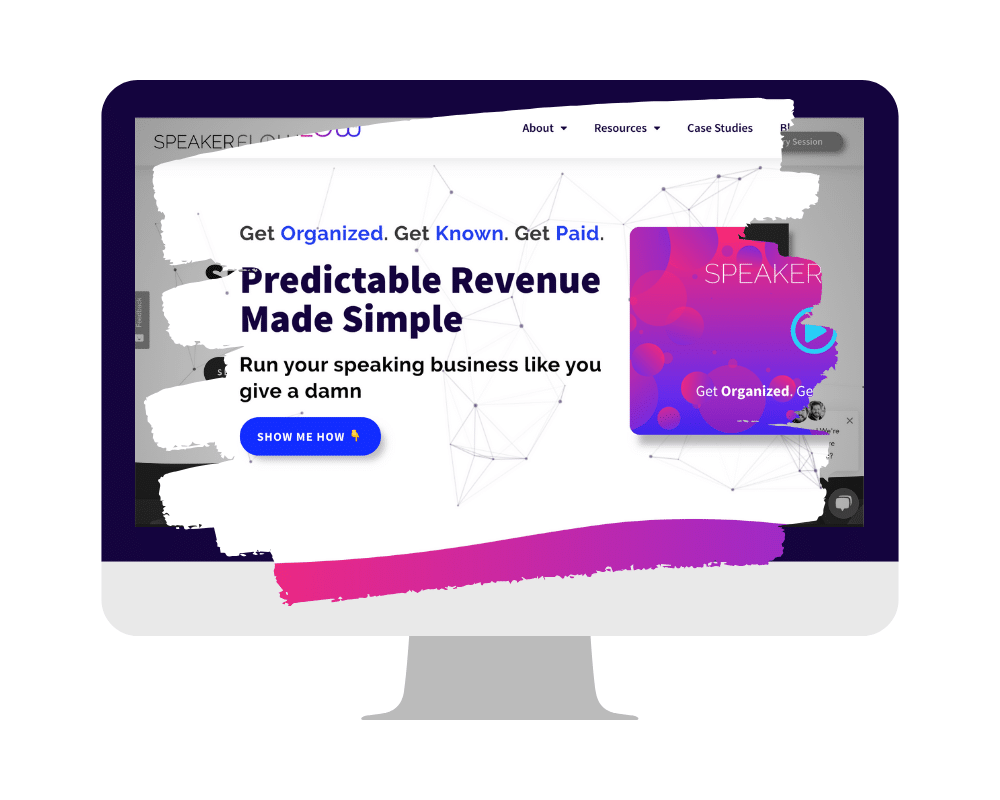
Transitioning away from sales, next on the list is updating your brand, if you haven’t done so recently. From your brand colors to the style of your website, everything about your brand plays a role in how event planners perceive you. Because of this, it’s important that your website, especially, has a clean and modern appearance on top of showcasing your value. Strictly in design terms, 2020 has already been a big year for a number of trends including gradients, bright colors, and curves. You can see this on the SpeakerFlow website as well as several of our favorite tools, such as Asana and Stripe. For more information, Elementor’s guide to the 12 top design trends of 2020 provides some awesome examples, too.
Aside from your website, rebranding is also a great opportunity to redo your business cards, presentation style, and speaker one sheet. By incorporating the above design trends into your digital presence and printed materials, you not only showcase your ability to evolve. You also demonstrate the ability to grow, making you all the more relevant. From planners at small events to CEOs of fortune 500 companies, every decision-maker wants to see this. After all, being willing to grow and adapt means you’ll be able to inspire their team to do so, too.
Above all, whether you choose to completely rebrand or lightly “refresh” your visual brand, the key is consistency. Rebranding for a modern appearance sets you apart in the speaking industry, without a doubt. However, if your image isn’t the same across the parts of your digital presence, you won’t see the benefits of visually leveling up. That means that if someone jumps from your Facebook page to your website to your speaker one-sheet, it should be blatantly clear that all below to you.
4. Block off a few hours each week to work on your speaking business rather than in it.
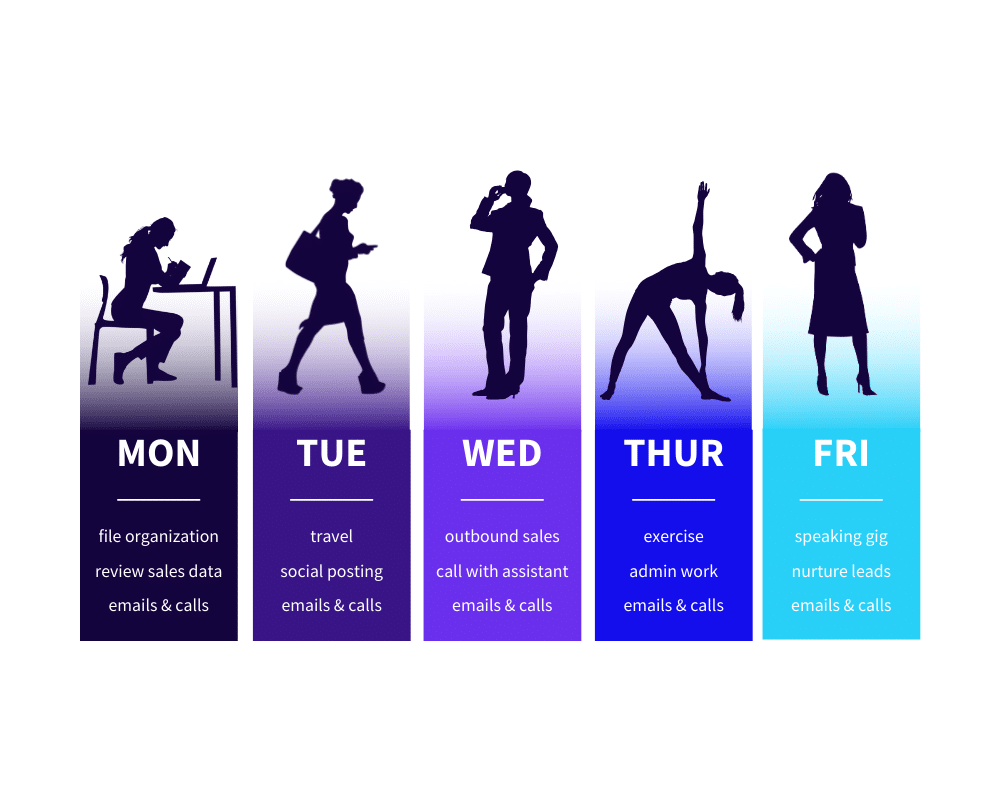
Speaking of things that below to you, don’t forget to make this a habit in your business! Most business owners within the speaking industry have a habit of neglecting the back end of their company because they’re so busy trying to bring in money for it. Ironically, spending time improving your processes and workflows ultimately results in more income over time.
As a member of a team that chronically overworks, this is something I’m still battling myself. For example, when SpeakerFlow began, we almost immediately needed to bring on more team members. Although this was essentially a good thing, as we had a ton of clients right off the bat, we couldn’t afford more employees to help handle them. It was a vicious cycle of needing more people to help balance our client load but not having enough income from clients to hire anyone.
Ultimately, this led us to block off Mondays, as a team, from client bookings. For the last six months, each of us has spent Monday’s meeting with our department heads, coordinating our plans and tasks, and providing feedback. In addition to camaraderie among our team members, this has also created greater efficiency overall and better problem-solving when we hit a roadblock in a given project. So, if you’re not providing any time to work on your speaking business, rather than in it, give it a shot. It won’t just allow you to start each week feeling caught up. You’ll also be able to knock out the last three tasks in no time.
5. Reach out for help where you need it!
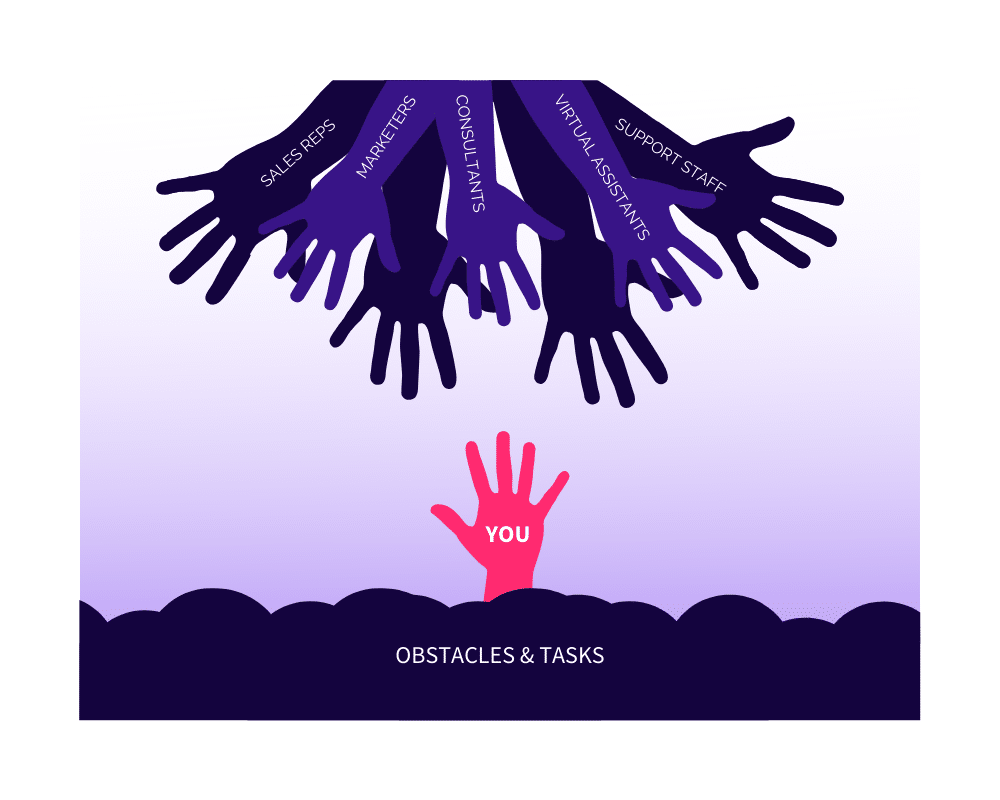
Finally, if you’re unsure where in your speaking business needs adjusting, just ask! There are a ton of free resources available throughout the speaking industry, including our Resources page, the SpeakerLab podcast, and the Speaker Launcher podcast. Each of these sources is exceptionally useful, even if you’re an experienced speaker. Plus, they all include free info on everything from technology to speaking styles to speaker associations and conferences. That way, all areas of your speaking business are covered, no matter what you’re worried about.
Additionally, for more hands-on training, many speaker consultants or coaches offer paid courses. Jane Atkinson at Speaker Launcher and Dawnna St Louis at High-Profit Zone (HPZ) are two examples of the in-depth boot camps available if you have a larger budget. For smaller budgets, Jane also offers an online course called the Wealthy Speaker School, and at SpeakerFlow, we offer consulting in addition to the technology mentioned previously. In short, we’re all about tech, but we also have the process to make the most of it.
Ultimately, the tools and processes you choose to adopt in your speaking business are entirely up to you. Nevertheless, this year’s numbers undeniably show the need for data-driven decisions and automation where you can. If you own speaking business stands out from these numbers, that’s amazing! I encourage you to keep up the good work in 2020.
If not, no worries! We’re all working towards becoming more efficient and confident in our sales, marketing, and operations processes. It’s just going to take some time. Until then, feel free to shoot us a message if you get stuck, and we’ll do whatever we can to help. 
For now, cheers to 2020 and best wishes as we all enter a new year in the speaking industry! 
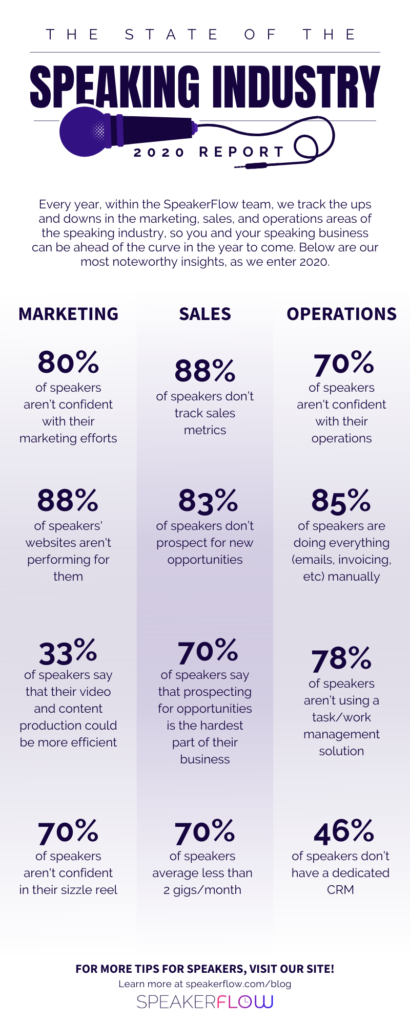
Information contained on this page is provided by an independent third-party content provider. Frankly and this Site make no warranties or representations in connection therewith. If you are affiliated with this page and would like it removed please contact pressreleases@franklymedia.com
More Like This
January 28th, 2020
April 23rd, 2024
April 23rd, 2024
April 23rd, 2024
Top Headlines
April 23rd, 2024
April 23rd, 2024
April 23rd, 2024






